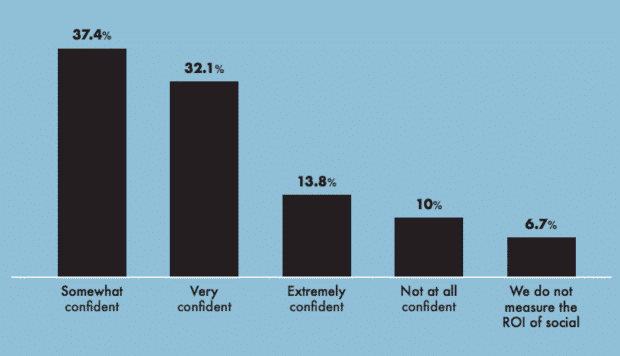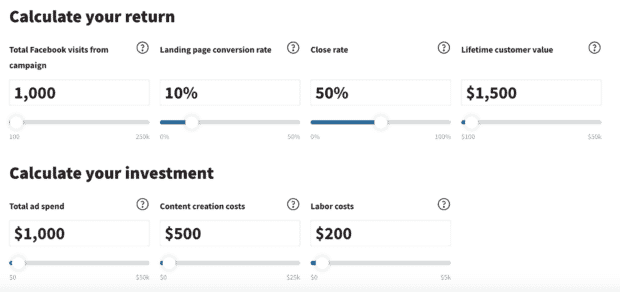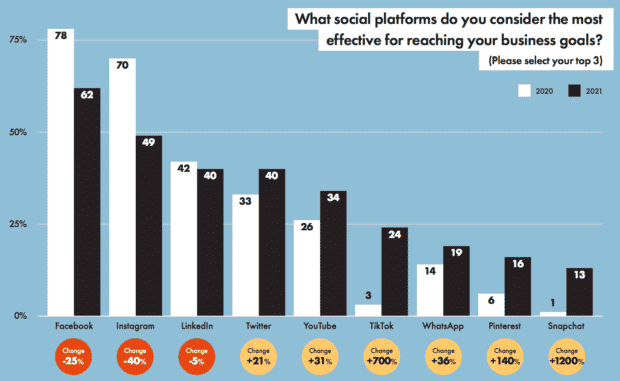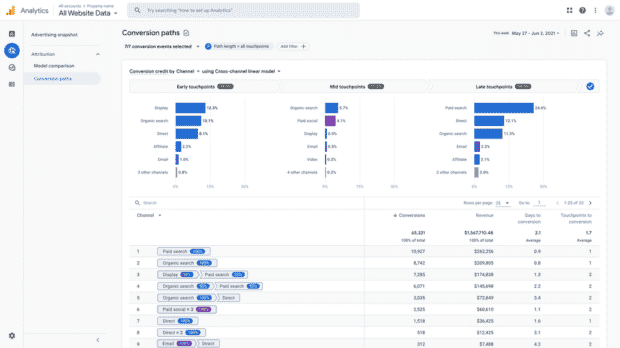Know your LTV from your YOY? How about your COGS from your conversion rate? If you’re drawing blanks, it’s time to recap a few marketing ROI formulas. Knowing some basic ROI formulas will help you better recognize the impact of your marketing campaigns and how to improve them.
Then when your boss says, “We gave you $50,000 to spend on Facebook ads –– what’s the return on investment [ROI]?” or “What’s our average growth rate for website traffic this quarter?” you’ll have all the answers.
Use these four formula for ROI to analyze and prove the impact of your social media and digital marketing channels. And make sure you also try out our free and easy-to-use calculator to see how your efforts are paying off.
Bonus: Download a free guide and checklist to help you convince your boss to invest more in social media. Includes experts tips for proving ROI.
What does ROI mean?
In general, ROI stands for return on investment. From a marketing perspective, though, ROI means the return on investment from your marketing activities and costs.
ROI is a measure of all marketing actions that generate value, divided by your investment to achieve those actions. Your ROI shows you which marketing activities generate the most value.
After accounting for the time, money, and resources used, what’s the noticeable return for your business? To find this answer, you’ll need to do a few simple calculations to determine which marketing campaigns benefited your business the most.
Here’s a basic ROI formula for marketing campaigns:
Marketing ROI = (Value achieved – investment made) / investment made X 100
When your ROI is above 0, your marketing investments are generating money for your business. We want a positive ROI! A negative ROI means that you invested more than you earned — in other words, you lost money.
Marketing ROI can seem complex at first, but once you know a few simple formulas, you’ll be able to tell if you hit your ROI goals straight away.
Marketers used to shy away from ROI calculations, but this is changing. More than 80% of respondents to the Hootsuite 2022 Social Trends survey said they are confident in quantifying social ROI. That’s a big jump from 68% in 2021.
Check out Hootsuite’s Social Trends report for the complete picture, or watch this short video on the state of social ROI:
How to measure marketing ROI: 4 marketing ROI formulas
How you choose to calculate marketing ROI depends on your campaign’s objectives.
These could be:
- Raising brand awareness
- Increasing engagement YOY
- Boosting conversions
- Increasing customer lifetime value (LTV)
Each of these objectives will influence which ROI formula you use in your calculations.
Here are four marketing ROI formulas to get you started.
Marketing ROI formula #1: How to measure basic ROI
Calculating ROI is surprisingly simple. But it’s easy to fall into a common trap: Using gross profit without including the cost of goods sold.
Here’s an example of a simple ROI calculation:
- Let’s say we’re an online fashion retailer. We spend $100 on Instagram Story ads and sell ten t-shirts at $25 each.
- Our revenue for those sales comes to $250 (10 shirts x $25).
- Now, we’ll subtract our marketing spend ($100) from gross sales ($250). After accounting for those Instagram Story ads, we’ve got $150.
- Next, we divide this number by our marketing investment ($100). Now we’ve got 1.5.
- We multiply 1.5 by 100 to find our ROI, which is 150.
ROI = (Total revenue – marketing investment / marketing investment) x 100
According to this basic calculation, our ROI would be 150%, an impressive return. But, unfortunately, it’s a bit too good to be true.
Sure, this is an easy way to calculate ROI. But those t-shirts weren’t free, so this answer is still incomplete.
You also need to consider what it costs to produce whatever you’re selling and subtract that cost from your gross revenue. It’s a good idea to calculate your marketing ROI based on your gross profit for your product or service, not your gross revenue.
Here’s a more accurate way to calculate your ROI.
To accurately measure ROI, you need to know a second calculation: The cost of goods sold. This number will include everything it costs to produce your products.
If you sell a $25 t-shirt and only make $10 in profit on each unit, you need to include that information in the ROI calculation.
ROI = ((Total revenue – total COGS – marketing investment) / marketing investment) x100
Total revenue: Sales generated by your marketing campaign (such as product purchases)
Total COGS: Cost of goods sold. For example, if we’re selling t-shirts, COGS will include raw materials, labor, and factory costs. (You probably won’t need to calculate this — your finance team will likely have all the COGS data you need)
- First, calculate your cost of goods sold (COGS) and add it to the ROI equation above. Let’s say in our example earlier, the finance department told us that for every $25 t-shirt we sell, we make $15 in profit. Our COGS would be $10 per unit sold.
- If we sold ten products in our Instagram Story ad campaign, our total COGS for that campaign is $100.
- Now, we can calculate our ROI. We sold ten products at $25 each, so our total revenue is $250. We know that our total COGS is $100. The $100 we spent on Instagram Story ads is our marketing investment.
- Subtract our COGS ($100) and marketing investment ($100) from our total revenue ($250), and you’ll get $50. Divide $50 by our total marketing investment of $100. This gives us 0.5. Multiply by 100 to give us the percentage: 50.
- Our ROI is 50%, meaning that our Instagram ads are a worthy use of company time, resources, and money.
Pro tip: We created a free social ROI calculator to help you calculate the return on your investment for a specific paid or organic marketing campaign. Simply enter your numbers, hit the button and you’ll get a simple, shareable ROI calculation based on customer lifetime value.
Using the above numbers, here’s how your return on investment would look:
Marketing ROI formula #2: How to calculate year-over-year growth
Our job as marketers is to drive growth and sales. And one of the best ways to demonstrate your results is with a year-over-year (YOY) comparison.
YOY is a common technique for accurately measuring growth since it helps to smooth over seasonal fluctuations. For example, if you’re an e-commerce business, strong December sales may be overshadowed by a Black Friday sales spike. Likewise, a viral blog post one month may make next month’s traffic stabilization look like a decline.
But you don’t need to wait for January to use YOY calculations. YOY can help you compare months, like how a traffic drop in July 2022 compares to your total traffic in July 2021. You can also analyze different quarters (known as quarter-over-quarter or QOQ).
It’s a simple calculation. Pick a metric you want to report on, such as total yearly website visits from Instagram.
Let’s say our 2021 yearly total was 100,000 visits and our 2020 yearly total was 90,000 visits.
- Subtract 100,000 (current year) from 90,000 (previous year). The difference is 10,000.
- Divide 10,000 by 100,000 (current year). The answer is .01.
- Multiply .01 by 100. The answer is 10.
- Your growth rate for 2021 was 10 percent, increasing social traffic from 90,000 visits in 2020 to 100,000 in 2021.
YOY Growth = ((Previous year total – current year total) / current year total) x 100
Regularly calculating YOY growth is also helpful for understanding which social platforms are most effective for reaching your goals.
For example, in 2020, you may have found that Facebook was most effective for reaching your marketing goals, but in 2021 you found that TikTok and YouTube overtook Facebook.
In the Hootsuite 2022 Social Trends survey, marketers report finding Instagram and Facebook less effective while TikTok and Pinterest are growing in importance. By calculating YOY growth, marketers can identify those channels that are growing or declining in importance.
Marketing ROI formula #3: How to calculate your conversion rate
Conversion rates are always a hot topic among marketers. People often complain of having an ultra-low rate when they know their campaigns are successful. But, if your conversion rate is low, don’t worry; you’re probably just calculating it wrong.
The problem is that tools like Google Analytics or Optimizely will automatically calculate your conversion rate for you. This aggregate number generally ends up in reports.
To calculate a basic conversion rate, follow these steps:
- First, define what a conversion is. It could be an ebook download, newsletter sign-up, product purchase, free trial request, or any other conversion you value.
- Divide the total goal completions in Google Analytics by the total visits (this can be social media traffic, general website traffic, or the total visits to your website).
- Multiply the answer by 100, and you’ll get your conversion rate. For example, ten newsletter sign-ups (Goal Completions) divided by 1,000 website visits equals 0.1.
- To find out what this looks like as a percentage, multiply 0.01 by 100. The answer is 10, so your conversion rate is 1%.
Basic conversion rate = (Total goal completions / total visits) x 100
“Wait, 1%?!” you’re thinking. “That can’t be right!”
The issue is that you’re using an aggregate number — such as total visits to your website — rather than the market segments you actually target. As a result, most conversion rates seem low.
Himanshu Sharma, author of “Maths and Stats for Web Analytics and Conversion Optimization,” offers an excellent tip for calculating a more accurate conversion rate.
As he explains, “Google Analytics will take every person on the planet into account when calculating your conversion rate metric.” Of course, this aggregate data isn’t exactly useful (if your company only ships products to the U.K., why would you report on people from Egypt that didn’t buy?).
Sharma has an easy solution: “Create and apply a new advanced segment (named ‘Traffic from Target Market’) in your Google Analytics view or profile which only shows traffic from your target market.” Now, you’ll see much more relevant traffic data, and your boss won’t always be asking you why only five percent of prospects convert.
To calculate a more accurate conversion rate, follow the same steps as above. This time, make sure the number you use for the total number of visits only includes your target market, using Google’s advanced segments to filter out irrelevant traffic sources.
True conversion rate =
(Total goals completions / total visits by target market) x 100
Using Google Analytics, you can also view the customer touchpoint by channel, giving credit to touchpoints from when your customers first arrive at your site.
Source: Google Marketing Platform Blog
Marketing ROI formula #4: How to calculate customer lifetime value (LTV)
Customer lifetime value measures how much a business predicts it’ll earn from the average customer throughout its relationship with the business. It’s a way to quantify the customer relationship.
You need to know the lifetime value (LTV) of your customers to create accurate marketing plans.
Consider a business like Netflix. Their basic plan is $9.99. Let’s say the average user signs up and stays with them for two years before canceling. Then, after Netflix’s email marketing ramps up or they announce a new season of a show like Stranger Things, the average user signs back up and stays another 15 months.
This means that an average customer is worth $389.61 to Netflix.
When running Facebook ads or offering discounts to win back customers, Netflix needs to keep this LTV figure in mind so that the marketing costs of acquiring customers do not eat away all the profit that customer is likely to bring in.
A simple way to calculate LTV
Depending on your business model, LTV can get quite complex to calculate. So today, we’ll stick to a simple way to calculate LTV.
LTV requires us to have a bit of data and answer four key questions. Here’s what you need:
1. Average Order Value (AOV): How much does the average customer spend in one visit? For a coffee shop, this might be how many lattes the average customer buys. For an online shoe retailer, it’s the average shopping cart amount.
Bonus: Download a free guide and checklist to help you convince your boss to invest more in social media. Includes experts tips for proving ROI.
How to work out your AOV:
- The best way to gather the data for AOV is to work with your finance team or accountant. Every business files taxes, so your accountant will know the total sales revenue you reported last year.
- Next, speak to your analyst team and get the total number of orders for the last year.
- Divide your total revenue by your total number of orders. This gives you the AOV.
If you don’t have an accounting team, download your sales revenue from PayPal or Stripe (or whatever you use), then download total sales orders from your shopping cart or payment system. If you use an ecommerce platform like Shopify, they usually make it easy to find these numbers.
2. Purchase Frequency (PF):
How often do customers purchase from you?
If you’re a coffee shop, you might see the same customers every week. But if you’re a mortgage broker, you might only see the same clients a few times in their lifetime.
How to work out purchase frequency:
A larger business will likely already track this data, but a smaller one can do a simple research study. For example, a coffee shop could use a loyalty card to track repeat customers. Or you can ask your data team to help.
All they need to do is divide the total number of orders by the number of unique customers. This gives your purchase frequency. For example, you could download all transactions from PayPal and analyze these in a spreadsheet.
3. Customer Value (CV): This is the average value of a customer. This is how much money we can reasonably expect to extract from our customer’s wallets.
How to calculate customer value:
- To calculate, you’ll use numbers from AOV and PF.
- Multiply your AOV number (see above) by your PF number. The answer will be your average customer value.
CV = AOV x PF
4. Customer’s Average Lifespan (CAL): How long will a customer stay a customer? A brand like Honda tries to make you a customer for life (buy a Civic in college, buy a minivan when the children come, and drive off into a sensible sunset in your tricked-out Accord). Of course, this varies from business to business.
Tying it all together: Calculating LTV
OK, you’ve gathered all the data for the metrics listed below:
- AOV – Average Order Value
- PF – Purchase Frequency
- CV – Customer Value
- CAL – Customer’s Average Lifespan
- CLV – Customer Lifetime Value
To calculate your LTV, just complete the formula below:
CLV = CV x CAL
Multiply your CV number by your CAL number. Boom! Now you know the average CLV of your customers.
Pro tip: Still baffled by ROI? Use our Social ROI toolkit to nail the basics. It includes three essential resources with simple guidance and clear frameworks.
Tools to help you track marketing ROI
Now that you know the formula behind calculating marketing ROI, here are a few tools to make it easier to track your ROI.
1. Excel or Google Sheets
Trying to calculate everything manually gets old pretty quick. It also leaves you open to making some obvious human errors. When you’re trying to keep track of many numbers, spreadsheet tools like Excel and Google Sheets come in handy. You can use them to calculate and track your marketing ROI benchmarks in one place.
Here’s an example of how you could use Excel to calculate your YOY growth rate:
- Open an Excel sheet and create three columns: A, B, and C.
- Enter the number “2020” in cell A1. In cell A2, enter “2021.”
- Put your 2020 total traffic, leads, or sales numbers in cell B1. In B2, put your 2021 total traffic, leads, or sales numbers.
- Go to cell C2 and type this formula in: =(B2-B1)/B1
- You now have your YOY growth rate in Column C.
Next, all you need to do is show your boss and wait for that promotion!
You can use Excel or Google Sheets to calculate all your campaign ROI formulas. Regularly calculating your ROI data after each campaign will help you track campaign ROI over time and identify trends for what performs best.
If you have a phobia of spreadsheets like me, you can purchase pre-built customizable templates like this one below. All you need to do is plug in your numbers, and the spreadsheet will do the rest for you.
Image source: Etsy
2. Hootsuite Impact
Hootsuite Impact measures social media marketing ROI across paid, owned, and earned social channels.
Impact syncs with your existing analytics systems so you can integrate your social data with the rest of your important business numbers. It makes generating reports way easier and provides plain-language recommendations to help you improve your social ROI.
Check out this 3-minute video learn more about using Hootsuite Impact:
You can even get automated reports sent straight to your inbox, so you don’t have to remember to pull them yourself.
Try Hootsuite for free. You can cancel anytime.
How to use your ROI calculations
Measuring marketing ROI helps you understand the effectiveness of your campaigns, highlight your value to your organization, and improve your strategy over time. Here’s how to better use your ROI calculations.
Understand what’s working (and what’s not)
Measuring your marketing ROI is key to building and optimizing your social marketing strategy. It highlights what’s working and what’s not. Instead of guessing at what your most effective campaigns were, ROI gives you concrete social media metrics. You can use these numbers to inform future strategic campaign decisions.
Prove the value of your work to leadership
Ever been told that marketing campaigns are just creative fluff? That kind of narrative ends with hard numbers in the form of a solid ROI. So next time your CEO says they want to cut your marketing budget, you can come back to them with concrete evidence that your campaigns deliver tangible value.
Knowing the ROI of your marketing campaigns demonstrates to leadership that resources, time, and budget are being well spent on your marketing campaigns.
Negotiate a higher budget for your team
It’s easier to justify spending money on strategies that deliver more value than they cost. So when you have a great track record for delivering a high ROI, you’ll be more likely to convince management to allocate a higher budget for your campaigns.
Remember the big picture
While calculating marketing ROI is an essential part of any campaign, don’t fixate on ROI to the point of forgetting your brand values.
Prioritizing campaigns just to get a few likes and comments doesn’t increase your brand value if it’s irrelevant to your audience. It could even damage your brand and audience relationship in the long term.
Knowing how to measure ROI in marketing isn’t just about chasing numbers, either. Marketing can also help you improve customer service and build employee relationships.
Track your social media performance and maximize your budget with Hootsuite. Publish your posts and analyze the results in the same, easy-to-use dashboard. Try it free today.
With files from James Mulvey.
All your social media analytics in one place. Use Hootsuite to see what’s working and where to improve performance.
The post 4 ROI Formulas To Help Earn You a Promotion appeared first on Social Media Marketing & Management Dashboard.











Recent Comments